Misunderstanding about Warm-Ups.
We have spent decades thinking warming up is literally about warming up the body and muscles. Specifically increasing muscle temperature, initiating metabolic and circulatory adjustments, as well as preparing psychologically for the upcoming task. There is an assumption that warm muscles and warm core temp will optimize performance. This comes from lab studies showing that an increase in muscle temperature increases the rate of force development and relaxation without modifying the peak tension (figure).

So far so good, but there are some problems with this observation. An increase in torque has not been consistently observed in vivo ie outside the lab. Second, the effect is also not really seen at normal ambient temperatures (15–25degC). Further, the effect is likely to be reversed in hot temperatures…..ie warming up above 25degC may actually be detrimental!
Why so? Muscle temp is only one variable determining performance. Also important are CORE temp, skin temp and even brain temperature. For example, when warming-up in hot and/or humid ambient conditions a classical warm-up risk an increase thermal and circulatory strain.

In hot conditions, fatigue has been shown to be less reliant on high absolute core temperature, but more dependent on hot skin temperature (> 35 °C) (or perhaps its 50:50); because fatigue can occur at relatively low core temperatures of approximately 38.5 °C (Latzka 1998).
Performance impairment can of course occur in both cold and hot environments and is partly related to a modification in neural drive. The amount of voluntary neural drive is reduced with hyperthermia as a protection mechanism whereas in cold temperatures there is also decline in coactivation and coordination.
So, today I am asking should we be undertaking efforts at cooling (not warming) during warm-ups? In a more sophisticated model I am asking should we be warming muscles, but keeping core temp and skin temp cool?
Time to look at the evidence………
What is Pre-Cooling?
In hot conditions it is likely gains can be made from pre-cooling during warm ups. This effect can be achieved from:
wind (fans)
cool drinks (or ice)
menthol mouth wash (mainly tested during event)
head cooling
cool jackets
Clearly, the degree and duration of effect will vary, and it is also possible to combine cooling strategies. But the most basic question is how do these compare to each other, and to no-precooling (but with warm up)…..in fact we could have these comparisons…..
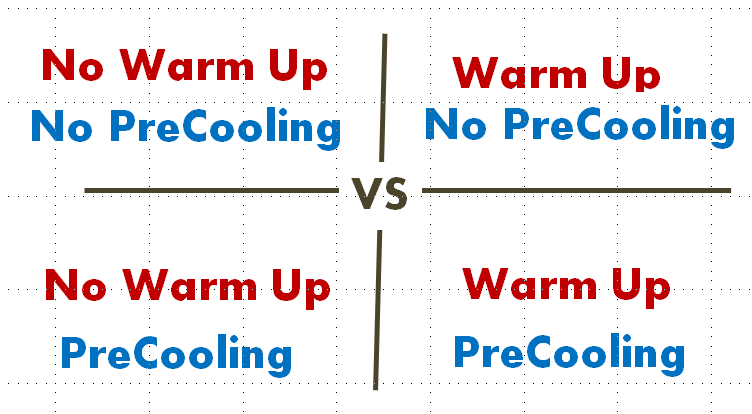
Also the usual question is…..
Usual warm up 🆚 warm up with pre-cooling in hot conditions
but I would also like to know
Usual warm up 🆚 warm up with pre-cooling in normal conditions
I suspect there are gains to be made there, but so far I can only find the first type of studies (ie hot conditions…..although each study does vary the temp quite a bit).
Some Individual Studies
Levels et al asked 10x athletes to do four 15-km time trials (@30°C) either using warm-up or warm-up with cooling (30m scalp cooling) or just cooling (ice ingestion + scalp cooling). This is what they found:
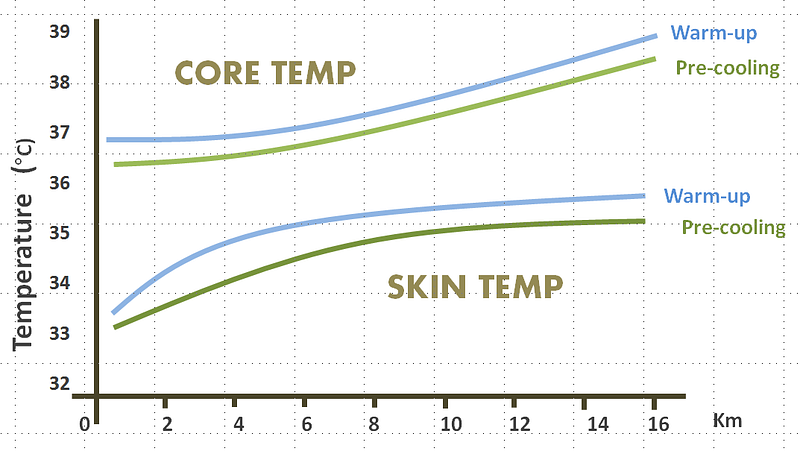
Pre-cooling had a modest but a significant effect on event skin temp and core temp…and Power output was lower for WARM-UP alone than than for cooling alone with warm up+cooling in the middle. So in this case, a normal warm-up alone was the worst option.

A similar result was found by Al-Horani et al (2018). In this study, 9x athletes completed three 16.1-km time trials @33°C after: precooling (ice slurry and ice vest) alone; warm-up alone. Results over 16km were as follows:
Cooling alone = 31.9 min
COMBO =32.6min
Warm-up alone = 33.1min
And again, the same story comes from this study from Faulkner et al who asked 10x cyclists to do a time trial on three occasions in hot (35 °C) with a pre-event cooling jacket vs warm-up alone.

So these three studies all say warming up is detrimental and somewhat rescued by pre-cooling.
But 😲 shock, horror cooling 😲 alone without a warm-up at all might be best!!
However, I note that the benefits of pre-cooling are less effective in short sprints even in repeated-sprints the effect may be a wash.
I am Too Cool? 😎
Just as you can go too hot (core >40 °C skin > 35 °C) you can risk going too cool. Core and muscle temperatures below 37.5°C and 38°C, respectively, are associated with reduced aerobic performance and peak oxygen uptake (VO2max) (citation: Berg et al, 1979).

So cooling can get excessive. An example where cooling during warm-ups might be going too far include cold water immersion. For example 30mins at water temperatures between 22−30°C (or just legs at 10−18°C). Such low temps are likely to have deleterious effects on nerve conduction rate and muscle contraction velocities.
META-ANALYSES OF PRE-COOLING
Although a large number of studies have been conducted, I have to admit they are small sized, relatively low quality in the most part. However this is where a meta-analysis will help. That’s when we bring all the studies together…..but we still need a large study for sure.
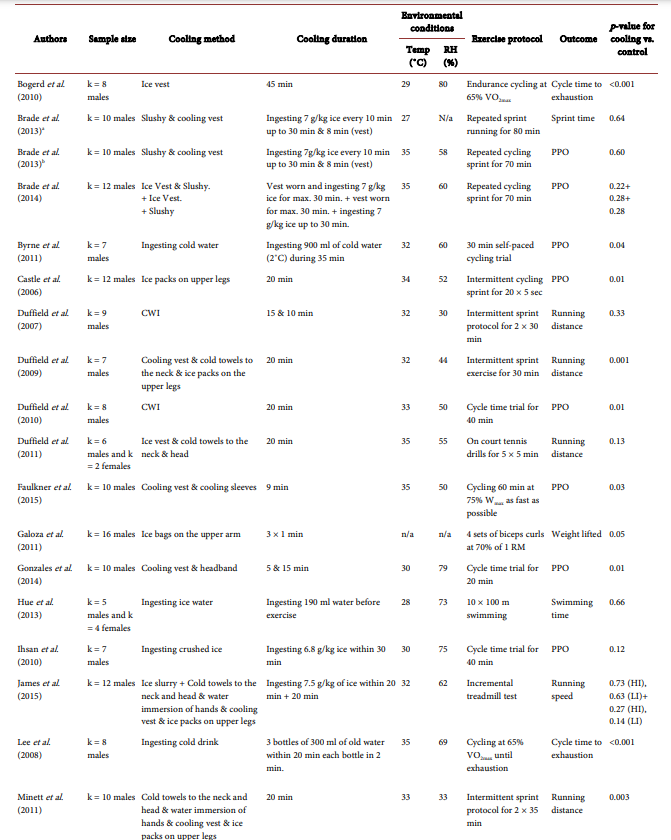
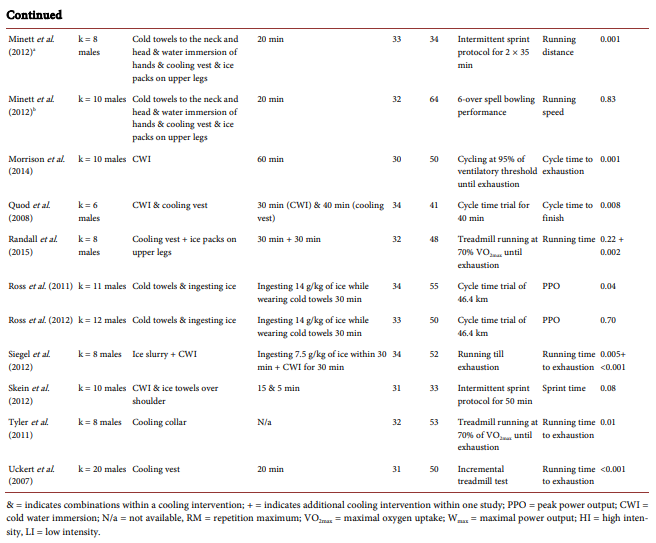
In one meta-analysis Rodriguez (2020) found 26 studies of pre-cooling techniques (exposure to ice water, cold packs, or cooling clothes, intake of cold water or ice). Cooling prior to exercise concluded increases in distance covered (1.5–13.1%), mean power output (0.9–6.9%), time to exhaustion (19–31.9%), work (0.1–8.5%), and mean peak torque (10.4–22.6%), as well as reductions in completion time (0.6–6.5%). Mixed strategies seemed to be the most effective techniques, being directly related with the duration of cooling and showing the major effects in prolonged exercise protocols.

Next, Roriz (2022) found 43 studies BUT including during event cooling (aka per-cooling) ……472 participants exercising between 22◦C (106) to 38◦C (131) an deg. 7 exclusively included a menthol solution mouth rinse, 30 exclusively involved ice slurry/ice slush/crushed ice/cold beverages intake, and 6 examined both the effect of thermal and non-thermal internal techniques in the same protocol.
Rinsing a menthol solution (0.01%) improved physical performance during continuous endurance exercise in the heat but mainly when taken during exercise.

Conversely, the pre-event ingestion of ice or cold beverages did not seem to consistently increase performance but co-administration of menthol with or within ice beverages seems to exert a synergistic effect by improving physical performance
What About Acclimatization?
These results apply to athletes exercising in hot environments who are not acclimatized to the heat. If you are acclimatized then skin temperature increases more slowly, as you sweat earlier than less-trained individuals and have other internal “cooling” adaptions.
Indeed no beneficial effects of pre-cooling were observed in terms of performance in acclimatized amateur trained runners (see James et al 2018). Two weeks of acclimatization offered similar results compared with cool conditions in terms of time when trained cyclists were subjected to a prolonged time trial. Crushed ice ingestion prior to exercise offered identical improvements in endurance cycling performance compared with a 12 day acclimatization training program (see Zimmermann 2018).
SUMMARY
If you warm up in hot conditions you will likely run the risk of overheating.
In hot conditions (eg over 25degC) you should try and cool down as a warm-up and forget the warm up totally!!
If it is possible acclimitize to hot conditions (for 2weeks+) but if not use cooling strategies.
You can test whether your race conditions will be a problem in our heat calculator here: https://fft.tips/heat
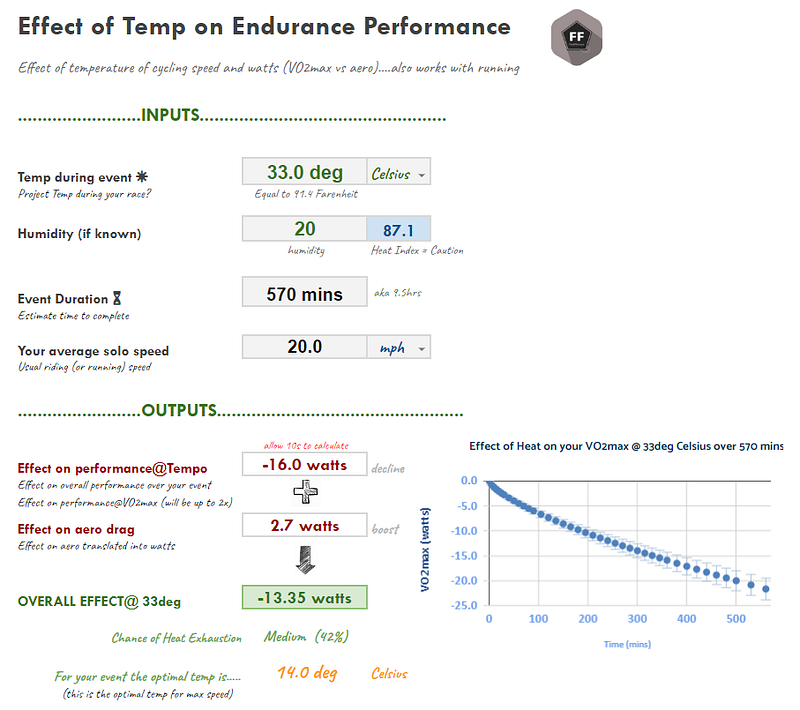
Heat calc will work out the relative effect of heat on physiological performance (expressed in watts) vs aero gains (due to lower air density)
CITATIONS
Bergh U, Ekblom B. Physical performance and peak aerobic power at different body temperatures. J Appl Physiol. 1979; 46:885–889
Faulkner SH, Hupperets M, Hodder SG, Havenith G. Conductive and evaporative precooling lowers mean skin temperature and improves time trial performance in the heat. Scand J Med Sci Sports. 2015 Jun;25 Suppl 1:183–9. doi: 10.1111/sms.12373. PMID: 25943669
James, C.A.; Richardson, A.J.; Watt, P.W.; Willmott, A.G.B.; Gibson, O.R.; Maxwell, N.S. Short-term heat acclimation and precooling, independently and combined, improve 5-km time trial performance in the heat. J. Strength Cond. Res. 2018, 32, 1366–1375
Latzka WA, Sawka MN, Montain SJ, Skrinar GS, Fielding RA, Matott RP, Pandolf KB. Hyperhydration: tolerance and cardiovascular effects during uncompensable exercise-heat stress. J Appl Physiol 1998: 84: 1858– 1864
Racinais, S.; Périard, J.D.; Karlsen, A.; Nybo, L.; Periard, J.D.; Karlsen, A.; Nybo, L. Effect of heat and heat acclimatization on cycling time trial performance and pacing. Med. Sci. Sports Exerc. 2014, 47, 601–606.
Racinais S, Oksa J. Temperature and neuromuscular function. Scand J Med Sci Sports. 2010 Oct;20 Suppl 3:1–18.
Zimmermann, M.; Landers, G.; Wallman, K.; Kent, G. Precooling with crushed ice: As effective as heat acclimation at improving cycling time-trial performance in the heat. Int. J. Sports Physiol. Perform. 2018, 13, 228–234
